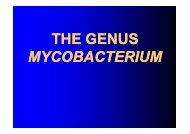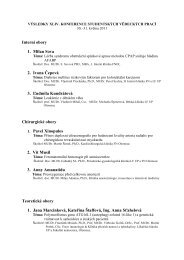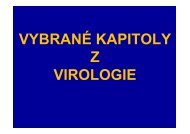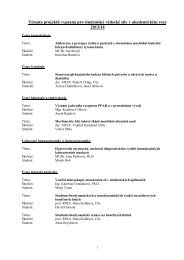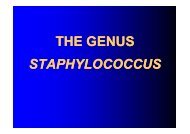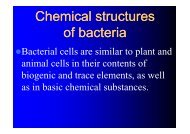SPORES - LF
SPORES - LF
SPORES - LF
Create successful ePaper yourself
Turn your PDF publications into a flip-book with our unique Google optimized e-Paper software.
<strong>SPORES</strong><br />
(endospores)<br />
the spore is formed inside the<br />
parent vegetative cell – hence the<br />
name „endospores“
The<br />
spore is a dehydrated, multishelled<br />
structure that protects and allows the<br />
bacteria to exist in „suspended<br />
animation“.<br />
It<br />
contains a complete copy of the<br />
chromosome, minimum concentrations of<br />
essential proteins and ribosomes, and a<br />
high concentration of calcium bound to<br />
dipicolinic acid.
Members of several bacterial<br />
genera are capable of forming<br />
Bacillus anthracis<br />
Clostridium tetani<br />
endospores:<br />
Clostridium botulinum<br />
Clostridium perfringens<br />
and other, but never gram-negative<br />
microbes
Spore formation is a means by which<br />
some bacteria are able to survive<br />
extremly harsh environmental<br />
conditions.<br />
The genetic material of the bacterial<br />
cells is concentrated and than surrounded<br />
by a protective coat, rendering the cell<br />
impervious to desiccation, heat and<br />
many chemical agents.
The bacteria in the stage of spore is<br />
metabolically inert and can remain stable for<br />
months to years. When exposed to favorable<br />
conditions, germination can occur, with the<br />
production of single cell that subsenquently<br />
can undergo normal replication.<br />
It should be obvious that the complete<br />
eradication of disease caused by sporeforming<br />
microorganisms is difficult or<br />
impossible.
The two major groups of bacteria<br />
that form spores are the aerobic<br />
genus Bacillus (e.g. disease<br />
anthrax) and the anaerobic genus<br />
Clostridium (e.g. disease tetanus,<br />
botulinismus).
Sporulation<br />
The sporulation process begins when<br />
nutritional conditions become unfavorable,<br />
depletion of the nitrogen or carbon source (or<br />
both) being the most significant factor.<br />
Sporulation occurs massively in cultures that<br />
have terminated exponential growth as a result<br />
of such depletion.
Sporulation involves the production of many<br />
new structures, enzymes, and metabolites<br />
along with the disappearance of many<br />
vegetative cell components.<br />
– These changes represent a true process of<br />
differentiation. A series of genes whose products<br />
determine the formation and final composition of<br />
the spore are actived, while another series of<br />
genes involved in vegetative cell function are<br />
inactivated.
Sporulation<br />
Morphologically, sporulation begins with the<br />
isolation of a nucleus by the inward growth of the<br />
cell membrane.<br />
The growth process involves an infolding of the<br />
The growth process involves an infolding of the<br />
membrane so as to produce a double membrane<br />
structure whose facing surfaces correspond to the<br />
cell wall-synthesizing surface of the cell envelope.<br />
The growing points move progressively toward the<br />
pole of the cell so as to engulf the developing spore.
Sporulation<br />
The two spore membranes now engage in the<br />
activity synthesis of special layer that will<br />
form the cell envelope:<br />
– the spore wall and cortex, lying between the<br />
facing membranes, and the coat and exosporium<br />
lying outside the facing membrane.<br />
In the newly isolated cytoplasm, or core, many<br />
vegetative cell enzymes are degraded and are<br />
replaced by a set of unique spore constituents.
Properties<br />
of<br />
endospores
Core<br />
The core is the spore protoplast.<br />
It contains a complete nucleus (chromosome), all of the<br />
components of the proteins-synthetizing apparatus, and<br />
an energy-generating system based on glycolysis.<br />
Cytochromes are lacking even in aerobic species, the<br />
spores of which rely on shorted electron transport<br />
pathway involving flavoproteins. A number of<br />
vegetative cell enzymes are increased in amount (eg.<br />
alanine racemase), and a number of unique enzymes are<br />
formed (eg. dipicolinic acid synthetase).<br />
The energy for germination is stored as 3-<br />
phosphoglycerate rather than as ATP.
Core<br />
The heat resistance of spores is due in part to their<br />
dehydrated state and in part to the presence in the<br />
core of large amounts (5 – 15% of the spore dry<br />
weight) of calcium dipicolinate, which is formed<br />
from an intermediate of the the lysine biosynthetic<br />
pathway.<br />
In some way not yet understood, these properties<br />
result in the stabilization of the spore enzymes,<br />
most of which exhibit normal heat lability when<br />
isolated soluble form.
Spore wall<br />
The innermost layer surrounding the<br />
inner spore membrane is called the spore<br />
wall.<br />
It contains normal peptidoglycan and<br />
becomes the cell wall of the germinating<br />
vegetative cell.
Cortex<br />
The cortex is the thickest layer of the spore<br />
envelope.<br />
It contains an unusual type of peptidoglycan,<br />
with many fewer cross-links than are found<br />
in cell wall peptidoglycan.<br />
Cortex peptidoglycan is extremly sensitive to<br />
lysozyme, and its autolysis plays a key role in<br />
spore germination.
Coat<br />
The coat is composed of a keratin-like<br />
protein containing many intramolecular<br />
disulfide bonds.<br />
The impermeability of this layer confers<br />
on spores their relative resistance to<br />
antibacteral chemical agents.
Exosporium<br />
The exosporium is a lipoprotein<br />
membrane containing some<br />
carbohydrate.
Spore structure - schematic<br />
cortex<br />
protein coat<br />
core<br />
spore wall<br />
exosporium
Germination<br />
The germination process occurs in<br />
three stages:<br />
–activation,<br />
–initiation,<br />
–outgrowth.
Activation<br />
Even when placed in an environment that<br />
favors germination (eg. nutritionally rich<br />
medium) bacterial spores will not germinate<br />
unless first activated by one or another agent<br />
that damages the spore coat.<br />
Among the agents that can overcome spore<br />
dormancy are heat, abrasion, acidity, and<br />
componds containing free sulfhydryl groups.
Initiation<br />
Once activated, a spore will initiate germination if<br />
the environmental conditions are favorable.<br />
Different species have evolved receptors recognise<br />
different effectors as signaling a rich medium.<br />
Binding of the effector activates an autolysin that<br />
rapidly degrades the cortex peptidoglycan. Water is<br />
taken up, calcium dipicolinate is released, and a<br />
variety of spore constituents are degraded by<br />
hydrolytic enzymes.
Outgrowth<br />
Degradation of the cortex and outer layers results in<br />
the emergence of a new vegetative cell consisting of<br />
the spore protoplast with its surrounding wall.<br />
A period of active biosynthesis follows. This period,<br />
which terminates in cell division, is called<br />
outgrowth.<br />
Outgrowh requires a supply of all nutrients essenial<br />
for cell growth.
The spore stain<br />
Spores are most simply observed as intracellular<br />
refractile bodies in unstained cell suspensions or as<br />
colorless areas in cell stained by conventional methods.<br />
The spore wall is relatively impermeable, but dyes can<br />
be made to penetrate it by haeting the preparation.<br />
The same inpermeability then serves to prevent<br />
decolorization of the spore by a period of alcohol<br />
treatment sufficient to decolorize vegetative cells. The<br />
latter can finnaly be counterstained. Spores are<br />
commonly stained with malachite green or<br />
carbolfuchsin.






